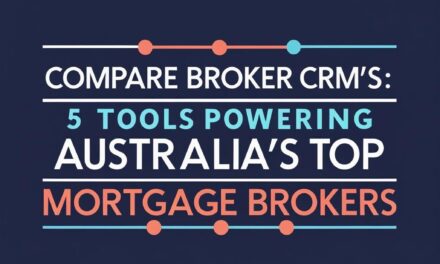Too Busy to Read? We’ve Got You.
Get this blog post’s insights delivered in a quick audio format — all in under 10 minutes.
This audio version covers: Your Competitive Edge is Coming: How the CDR Non-Bank Rollout Will Transform Your Business
Your Competitive Edge is Coming: How the CDR Non-Bank Rollout Will Transform Your Business
The final frontier of the **Consumer Data Right (CDR)**—the inclusion of non-bank lenders—is no longer a theoretical concept. With a mandatory rollout beginning in mid-2026, this expansion is poised to be one of the most significant competitive and compliance game-changers for Australian mortgage brokers since the introduction of Responsible Lending.
For busy brokers, this isn’t just another regulatory update to file away. It’s a fundamental shift in how data flows through our industry, creating a two-phased opportunity to radically sharpen your value proposition, streamline compliance, and deliver unparalleled service to your clients. Brokers who prepare for this change will gain a significant advantage, while those who don’t risk being left behind.
Let’s break down what’s coming and the practical steps you can take to prepare.
Phase 1: Unprecedented Market Transparency (From July 2026)
The first and most immediate change begins on **13 July 2026**, when non-bank lenders must comply with Product Data Sharing obligations.
What this means for you:
For the first time, the entire non-bank lending market will be required to publish their complete product offerings—including all rates, fees, and eligibility criteria—in a standardized digital format. The days of chasing updated product guides, deciphering complex policy PDFs, and relying on outdated spreadsheets are numbered. You will have access to a live, transparent, and comprehensive view of the non-bank product landscape.
The Challenge & The Opportunity:
This creates a firehose of data. Manually sifting through it will be impossible. The opportunity lies in leveraging technology that can instantly ingest and interpret this information.
This is where next-generation broker platforms become essential. An all-in-one system like **CreditPolicy**, for example, is built for this future. Its AI Policy Engine can connect directly to this standardized data feed, allowing you to run complex client scenarios and find the perfect product match across dozens of lenders in seconds, not hours. It turns a flood of data into a decisive competitive advantage, ensuring your recommendations are always based on the most accurate, up-to-the-minute information available.
Phase 2: Supercharging Compliance & Advice (From November 2026)
The second wave of the rollout is even more transformative. Starting **9 November 2026**, the Consumer Data Sharing obligations commence, allowing brokers, as “trusted advisers,” to access their clients’ verified financial data directly with their consent.
What this means for you:
This is a seismic shift for compliance and efficiency. The core requirements of ASIC’s Responsible Lending obligations (RG 209)—making “reasonable inquiries” and taking “reasonable steps to verify” a client’s financial situation—are fundamentally streamlined. Instead of manually collecting and verifying bank statements, payslips, and expense summaries, you can receive a secure, digitally verified snapshot of your client’s finances.
The Challenge & The Opportunity:
This moves the broker’s role away from administration and firmly toward strategic advice. With less time spent on data entry and verification, you have more time to analyse, strategise, and provide genuine value. Furthermore, this creates a perfect, verifiable digital audit trail, substantially mitigating your compliance risk.
To truly leverage this, brokers need tools that can translate this raw data into actionable insights. This is the domain of AI-powered assistants like **BrokerBuddie**. Imagine using its ComplianceBuddie feature, which can take a client’s CDR-verified financial data and automatically cross-reference it against your lender policy requirements and RG 209 checklists. Or using ResBuddie to instantly analyse a client’s financial position and not only identify suitable products but also pre-emptively flag potential servicing issues. These tools don’t just speed up the process; they add a layer of intelligence and rigour that’s impossible to achieve manually.
Your Action Plan: A Broker’s Checklist for CDR Readiness
The changes are coming fast. Here’s a simple framework to ensure you’re ready to capitalise on them.
- Educate Yourself & Your Team: Get familiar with the CDR rollout dates. Discuss within your team how these changes will impact your current workflow, from initial client conversations to application submission.
- Audit Your Tech Stack: Your current software needs to be CDR-ready. Ask your provider what their plan is for integrating both product and consumer data feeds. If they don’t have a clear answer, it’s time to explore modern platforms built for the future of broking. Look for tools that feature AI policy engines (**CreditPolicy**) and intelligent assistants (**BrokerBuddie**) as these are the systems that will thrive in a data-rich environment.
- Refine Your Client Conversation: Start educating your clients now. Frame the CDR as a major benefit to them—a secure and fast way to share their information that will lead to quicker approvals and more accurate recommendations. Reassure them that their data is protected and only shared with their explicit consent.
- Rethink Your Value Proposition: The future of broking is less about finding a rate and more about providing strategic advice. With data access being democratised, your expertise in structuring complex deals, negotiating with lenders, and guiding clients through their financial journey becomes your key differentiator.
The Final Takeaway
The CDR rollout for non-bank lenders isn’t a threat—it’s the single biggest opportunity on the horizon for brokers to enhance their efficiency, solidify their compliance, and deliver immense value to clients.
The shift begins in 2026, but the time to prepare is now. By embracing the change and adopting the right technology, you can position your brokerage to not just survive, but to lead in the new age of open data.
Start Your CDR Readiness Assessment Now





